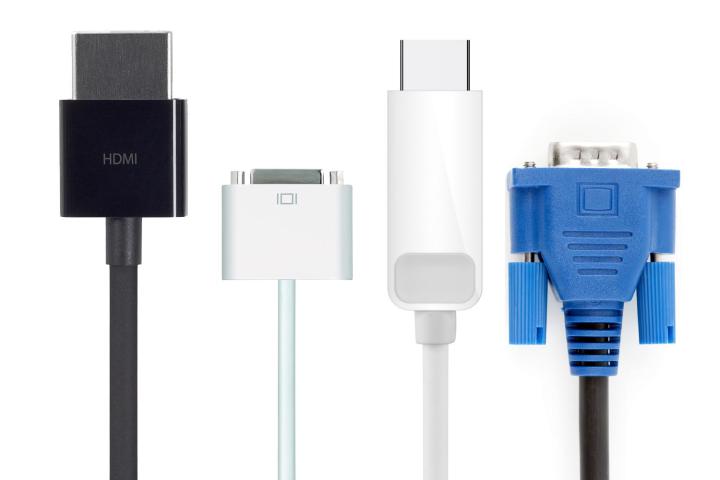
HDMI
These days, virtually all TVs and computer monitors support an HDMI connection. HDMI, which stands for High-Definition Multimedia Interface, shoots both digital audio and video down the same cable. Chances are, if you are trying to connect something to your television – and that includes computers – you’re going to want to use HDMI.
HDMI is used in a very broad array of consumer electronics products, including laptop and desktop computers, mobile devices, the Chromecast dongle, Roku’s streaming stick, Blu-ray players, HD cable boxes, and much, much more – so it’s a familiar and appealing format for most folks, and easily the most popular among general consumers.

After the introduction of
Since HDMI has progressed to this new version, there’s now even less reason to go with any of these other types of connections, except in some very specific situations, which we cover below.
DisplayPort
A digital display interface developed by the Video Electronics Standards Association (VESA), DisplayPort isn’t an option for consumer-level HDTV use (unless you plan on owning Panasonic’s top-of-the-line 4K TV, which is the only consumer television we are aware of that supports DisplayPort). However, DisplayPort is a perfectly capable option (some would say preferred) for connecting your PC to a computer monitor. With all of the necessary hardware add-ons and software updates, DisplayPort version 1.2 offers a maximum resolution of 3,840×2,160 at 60 FPS, which makes it ready to tackle

While the current version of DisplayPort is 1.2, VESA recently announced plans to issues 1.2a, which is meant to tackle graphical tearing and stuttering problems by integrating something called Adaptive-Sync. The new technology will attempt to eliminate the problem by aligning a computer’s hardware to match up the system’s GPU with the monitor’s refresh rate. Adaptive-Sync is also rumored to be able to draw down refresh rates for less demanding tasks, possibly resulting in decreased power consumption.
DVI
DVI (Digital Visual Interface) rose to prominence as the standard display connection format around 1999, but over time HDMI has effectively replaced it. DVI is designed to deliver uncompressed digital video and can be configured to support multiple modes such as DVI-D (digital only), DVI-A (analog only), or DVI-I (digital and analog). The digital video signal passed over DVI ends is essentially identical to HDMI, though there are differences between the two formats, namely DVI’s lack of an audio signal.

There are two different types of DVI connectors, single-link and dual-link. The dual-link DVI connector’s pins effectively double the power of transmission and provide higher speed and signal quality. For example, an LCD TV using a single-link DVI connector can display a maximum resolution of 1920×1200 – dual-link’s maximum for that same screen is 2560×1600.
VGA
Once the industry standard and now a video connector with one foot already out the door, VGA (Video Graphics Array) is an analog, video-only connection that’s rarely seen on TVs anymore, though you’ll still find it lingering on older PCs and projectors.

We don’t recommend going out of your way to use VGA, but if it’s all you’ve got laying around – and you’re not particularly picky about picture quality – it will do in a pinch.
Sometimes the 15-pin connector is referred to as “PC-RGB,” “D-sub 15” or “DE-15,” and some
Conclusion
If you’re connecting to a television, HDMI is the way to go. If you’re a gamer or find yourself on a computer all day, DisplayPort might be your best option, especially now that it has become more popular and, thus, supported. DVI and VGA are still solid computer monitor connections, but VGA is limited in its image quality potential, and won’t be a topic of conversation much longer. At the end of the day, we stand behind HDMI and DisplayPort as the top connections of choice.
Editors' Recommendations
- Sonos Beam vs. Sonos Playbar
- AirPods vs. Beats Powerbeats Pro: An Apple earbuds showdown
- HDMI vs. DisplayPort
- Apple AirPods vs. Sony noise-canceling WF-1000XM3


